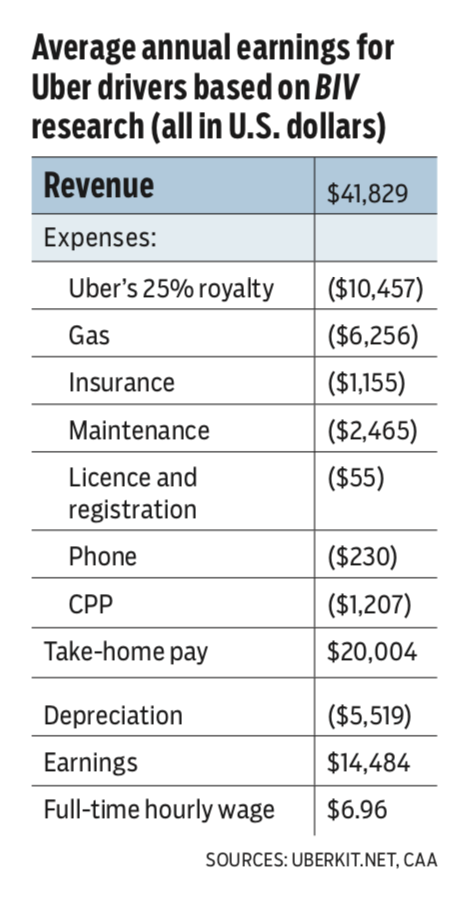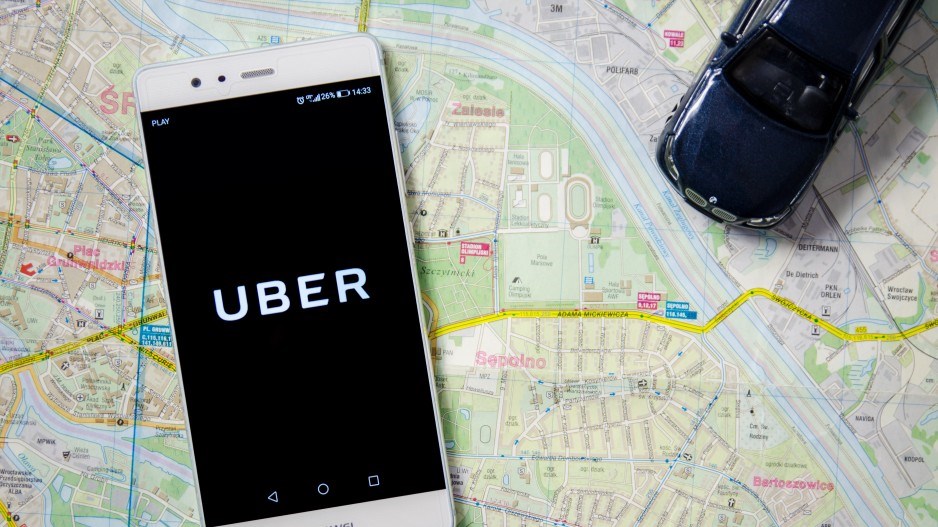Uber has billed itself as the most flexible way for people to earn extra cash.
The company is so focused on branding itself as an easy part- time way to earn additional money that it has even made special efforts to attract Chicago teachers during summer months, offering educators a $250 sign-up bonus after they complete their first 10 rides.
Neil Griffin, a former Greater Toronto Uber driver, said he started driving to earn extra money.
“[But] it’s really tough to make a living off of it, mainly for wear and tear and gas on your car. It depends on who you are if Uber would work for you.”
According to data collected and calculations made by Business in Vancouver, full-time Uber drivers can expect to generate, on average, revenue of up to US$41,829 annually with a 34.4% profit margin. This means that the hourly pay rate could be as low as US$6.96 per hour once all costs are accounted for.
Griffin is a standup comedian in the Toronto area and works for the city. He started driving for Uber last winter based on a friend’s recommendation.
Griffin said the challenge with the business model comes when people try to turn Uber driving into a full-time job.
As with any business, there are strategies for success. Organizations like Uberkit.net, Ridester.com and Uber have tried to pro- vide drivers with resources to help them develop a game plan for success. Waiting in your car for rides at busy locations and breaking up the workday into peak times are some of their suggestions for boosting driver earnings.
However, there’s a slight hiccup.
“They would tell you secrets, and those sometimes worked,” said Griffin. “But the problem is there are 50 other guys doing the same thing.”
Griffin estimated that on aver- age he made roughly $16 or $17 an hour, about US$13. Some days he’d make $60 for a few hours of work; other days the Uber app wouldn’t “go off,” meaning he would make no trips and no money.
So how profitable is it for driv- ers to operate an Uber driver business?
Stephen Zoepf, formerly of the Massachusetts Institute of Tech- nology, tried to pin down how much an Uber driver can expect to earn, despite not having access to Uber’s data.
He released a working paper
calculating that Uber drivers made US$3.37 per hour. After rebukes from Uber over concerns about a revenue assumption made, Zoepf adjusted his number to a range of US$8.55 to US$10 per hour.

Business in Vancouver reviewed two separate sets of data calcu- lating the average revenue for Uber drivers across 16 North American cities for which data was available from Uberkit and ridester. Differing methodologies and assumptions surrounding the length and frequency of trips resulted in a variance in the statistics calculated by the two sources.
According to Uberkit, Uber drivers can expect to make an average of US$41,829 annually before Uber’s 25% cut and operating expenses. However, ridester’s numbers were 25% lower on aver- age, suggesting that Uber drivers can expect revenue of only US$30,995 annually before all ex- penses. Of the 16 cities reviewed, only one of the three Canadian cities included were in the top half of Uber’s driver earnings, based on the ridester data. Toronto Uber drivers had the fifth-highest revenue at $55,824 (US$38,602), based on the ridester data.
Montreal and Calgary drivers had the 10th- and 11th-highest rev- enue at $36,091 (US$27,666) and $36,029 (US$27,618), respectively.
The largest expense for drivers is the 25% commission paid on each trip. After Uber takes that 25%, drivers still need to cover the costs of their car, gas and in- surance. One of the higher costs incurred by drivers is the addi- tional maintenance required as a result of driving significantly more kilometres (km), said Grif- fin. According to the Canadian Automobile Association (CAA), the typical driver travels 18,000 km a year. An average full-time Uber driver logs 80,000 km, which means maintenance costs that would normally take years to incur could be required annually. According to CAA information, a compact vehicle driven 80,000 km would require maintenance totalling $3,216, or approximately US$2,465. However, that wasn’t the expense that caused Griffin to leave Uber roughly half a year after he started.
Rising gas prices pushed Griffin out of the ride-hailing industry. Nationally they rose 11.1% to $1.20 per litre in January 2018 from $1.08 in August 2017. Metro Vancouver’s transit tax, which raises gas prices in the region above those elsewhere in the country, could make it even more difficult for Vancouver drivers compared with those in the rest of Canada other expenses for Uber drivers include licensing and registration fees and a cellphone data plan needed to use the Uber app. As contractors, drivers are also responsible for both the employee’s and employer’s contribution to the Canada Pension Plan.
While gas and maintenance are obvious upfront costs for the drivers, the general depreciation in the vehicle’s value as a result of the number of kilometres driven is a cost that is often overlooked. Assuming a compact car has a useful life of 240,000 km with a 10% salvage value, a compact car that is driven 80,000 km a year could be expected to depreciate a minimum of 30% in one year. For example, depreciation on a US$18,000 Honda civic would be approximately US$5,400 annually. After expenses, excluding depreciation, the average Uber driver can expect to earn US$9.62 an hour according to calculations using Uberkit data or US$6.10 an hour based on Ridester data. However, once depreciation is factored in, the hourly income would drop to US$6.96 and US$3.44, respectively.




